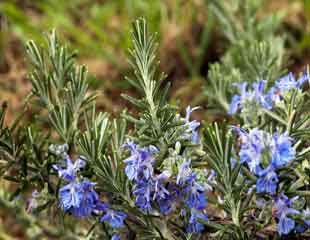


How to Grow Rosemary

Rosemary is a perennial evergreen shrub which will grow outside all year round. This Mediterranean type herb grows best in a warm sheltered sunny spot with well-drained soil. The upright form of Rosemary, which is more commonly grown and is the familiar garden shrub variety, is H4 hardy and can survive well in the garden if planted in well-drained soil.
Rosemary officinalis is now known as Salvia rosmarinus and is now a member of the Sage family.
All the Mediterranean type of herbs dislike having their roots in cold, wet soil or being in a cold wind. This can cause the needles to go brown and die back. In the winter of 2018, when we suffered the Beast from the East, with bitterly cold biting winds. I had an established Rosemary 'Miss Jessopp's Upright' in the garden, but this weather was too much and it died. I replanted a new shrub in a more sheltered spot.
The upright form illustrated above, which when grown in ideal conditions, can reach a height of 1.5 meters. You can clip it into topiary shapes. When pruning, make sure not to cut into the wood, as the plant will not recover.
There is also creeping, horizontal form, Salvia rosmarinus (Prostrata group,) illustrated right. Both varieties of Rosemary are H4 hardy, and need a sheltered spot.
Salvia rosmarinus Prostrata trailing Rosemary

There is also creeping, horizontal form, Salvia rosmarinus Prostrata group which is a trailing form. It's illustrated top right and left. This form of Rosemary is less hardy H3 which is described as hardy in coastal and relatively mild parts of the UK tolerating temperature down -5 to 1. I have seen it described as both Hardy and Semi Hardy.
This image is the trailing variety growing in a public garden in Rutland UK, with no winter protection and it looks healthy enough. Not a particularly sheltered spot, but Rutland, being in the East, is a dry area and its growing in a container. As always, individual planting conditions can make all the difference.

This variety can also grow into an attractive ball shaped and is very versatile if you have the right growing conditions.
The usual gardening advice is to plant it in a sheltered spot and/or to provide winter protection. It will also always do better on well-drained soil as the winter wet is as much as an enemy as the cold.
How to propagate Rosemary by cuttings
Rosemary is difficult to grow from seed, and the much preferred method of propagation is by cuttings. Take cuttings after flowering and snip off a length about 10-15 cm. Remove all the lower needles/leaves. If you can find a node, which is a bump in the stem, insert the cuttings into a plant pot just below the node of gritty compost. If you cannot locate the node, just push the cutting in. Water well.
In the early stages, it is important that the cuttings do not dry out, and this is best done by placing in a propagator or placing a plastic bag over the pot, secured by an elastic band to seal in the moisture. ( This is how to make a cheap home made propagator, scroll down on this page for details or short video) Place out of direct sunlight in a shaded area, leave for a few weeks and then check the container for signs of growth and roots in the bottom. It is best to let the plant grow on and mature for a season before planting out into the garden.
How to Prune Rosemary
Do you wonder why your Rosemary does not flower well?
It may be because, like me, you are cutting and snipping off the growing points for cooking and inadvertently cutting off the wood on which the flowers would form. Rosemary flowers on old wood, this means if you are going to prune it, do so immediately after flowering. Also, it is not advisable to prune into the old wood as it may not regenerate.
Recommended varieties of Rosemary to Grow
Between 2017-2021, the RHS conducted a trial of Rosemary at Wisely.
Some suggested varieties that earned the RHS award of garden merit to grow:
1. The longstanding favourite 'Miss Jessopp's Upright' retained its position and is a lovely garden variety;
2.A pink flowering variety S. rosmarinus 'Rosea' .
3.'Majorca Pink' which has pink flowers pink and an arching habit.
4. Rosemary ‘Severn Sea’ an upright variety, with light flowers slightly tinted blue.
Although the Prostrata Rosemary does not have the AGM, it's a very attractive form and well worth growing.
